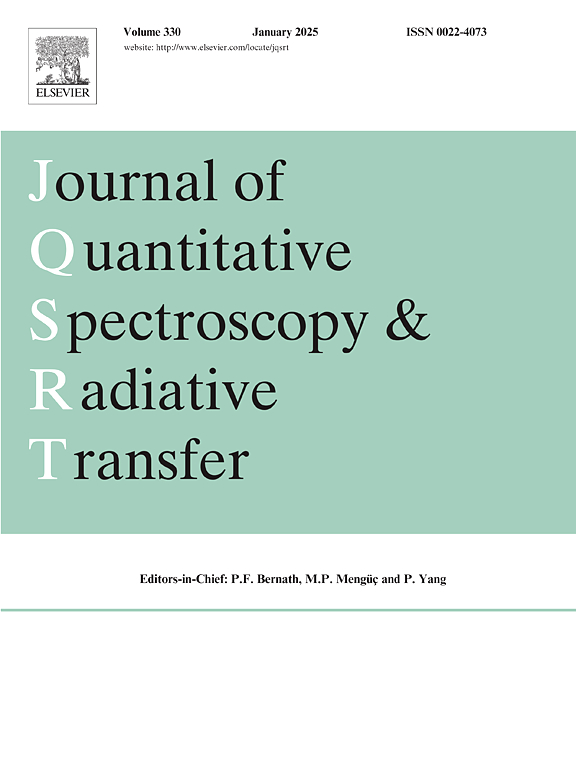Measurements of infrared absorption cross-sections for 1H-perfluorohexane and perfluoro-2-methyl-2-pentene from 300 to 340 K
IF 2.3
3区 物理与天体物理
Q2 OPTICS
Journal of Quantitative Spectroscopy & Radiative Transfer
Pub Date : 2025-04-22
DOI:10.1016/j.jqsrt.2025.109469
引用次数: 0
Abstract
1H-perfluorohexane and perfluoro-2-methyl-2-pentene are polyfluoroalkyl and perfluoroalkyl substances, respectively. Such substances are of general interest due to their ubiquity in industry and adverse health effects. To our knowledge, perfluoro-2-methyl-2-pentene has not been measured before in the infrared, and a single measurement of 1H-perfluorohexane exists. This work provides infrared absorption cross-sections for each molecule between 515 and 4000 cm−1 at 0.1 cm−1 resolution from 300 to 340 K to quantify their potential climate impact. Our results can also aid in detecting both molecules during the disposal of heavier per- and polyfluoroalkyl substances. We supplement experimental measurements with density functional theory cross-sections using the DSD-BLYP-D3BJ functional and the def2-TZVPPD basis set. We calculate integrated cross-sections, radiative efficiencies, and global warming potentials from experimental and theoretical cross-sections. Based on experimental data, the 100-year global warming potentials are 3120±410 and 37±9 for 1H-perfluorohexane and perfluoro-2-methyl-pentene, respectively. Our experimental and density functional theory climate metrics are substantially smaller than the theoretical values provided in The Scientific Assessment of Ozone Depletion: 2022.

h -全氟己烷和全氟-2-甲基-2-戊烯在300 ~ 340 K范围内红外吸收截面的测量
h -全氟己烷和全氟-2-甲基-2-戊烯分别是多氟烷基和全氟烷基物质。这类物质由于在工业中无处不在和对健康的不利影响而引起普遍关注。据我们所知,全氟-2-甲基-2-戊烯以前还没有在红外线中被测量过,而h -全氟己烷存在一次测量。这项工作提供了每个分子在515和4000 cm−1之间的红外吸收截面,分辨率为0.1 cm−1,从300到340 K,以量化它们的潜在气候影响。我们的结果也可以帮助在处理较重的全氟烷基和多氟烷基物质时检测这两种分子。我们使用DSD-BLYP-D3BJ泛函和def2-TZVPPD基集,用密度泛函理论截面补充实验测量。我们从实验和理论截面计算了综合截面、辐射效率和全球变暖潜势。基于实验数据,h -全氟己烷和全氟-2-甲基戊烯的100年全球变暖潜势分别为3120±410和37±9。我们的实验和密度泛函理论气候指标远小于《臭氧消耗科学评估:2022》中提供的理论值。
本文章由计算机程序翻译,如有差异,请以英文原文为准。
求助全文
约1分钟内获得全文
求助全文
来源期刊
CiteScore
5.30
自引率
21.70%
发文量
273
审稿时长
58 days
期刊介绍:
Papers with the following subject areas are suitable for publication in the Journal of Quantitative Spectroscopy and Radiative Transfer:
- Theoretical and experimental aspects of the spectra of atoms, molecules, ions, and plasmas.
- Spectral lineshape studies including models and computational algorithms.
- Atmospheric spectroscopy.
- Theoretical and experimental aspects of light scattering.
- Application of light scattering in particle characterization and remote sensing.
- Application of light scattering in biological sciences and medicine.
- Radiative transfer in absorbing, emitting, and scattering media.
- Radiative transfer in stochastic media.

 求助内容:
求助内容: 应助结果提醒方式:
应助结果提醒方式:


